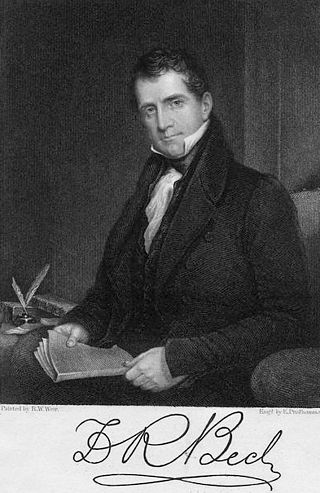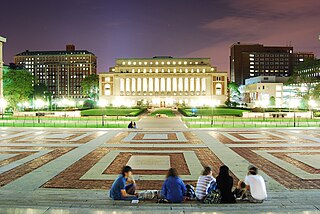
Frederick Augustus Porter Barnard was an American academic and educator who served as the 10th President of Columbia University. Born in Sheffield, Massachusetts, he graduated from Yale University in 1828 and served in a succession of academic appointments, including as Chancellor of the University of Mississippi from 1856 to 1861. He assumed office as President of Columbia University in 1864, where he presided over a series of improvements to the university until his death in 1889. He was also known as an author of academic texts.

Gallaudet University is a private federally chartered university in Washington, D.C., for the education of the deaf and hard of hearing. It was founded in 1864 as a grammar school for both deaf and blind children. It was the first school for the advanced education of the deaf and hard of hearing in the world and remains the only higher education institution in which all programs and services are specifically designed to accommodate deaf and hard of hearing students. Hearing students are admitted to the graduate school and a small number are also admitted as undergraduates each year. The university was named after Thomas Hopkins Gallaudet, a notable figure in the advancement of deaf education.

Thomas Hopkins Gallaudet was an American educator. Along with Laurent Clerc and Mason Cogswell, he co-founded the first permanent institution for the education of the deaf in North America, and he became its first principal. When opened on April 15, 1817, it was called the "Connecticut Asylum for the Education and Instruction of Deaf and Dumb Persons," but it is now known as the American School for the Deaf.

Castleton University was a public university in Castleton, Vermont.

Columbia College is the oldest undergraduate college of Columbia University, a private Ivy League research university in New York City. Situated on the university's main campus in Morningside Heights in the borough of Manhattan, it was founded by the Church of England in 1754 as King's College by royal charter of King George II of Great Britain. It is Columbia University's traditional undergraduate program, offering BA degrees, and is the oldest institution of higher learning in the state of New York and the fifth oldest in the United States.

Edward Miner Gallaudet, was the first president of Gallaudet University in Washington, D.C. from 1864 to 1910.

Princeton Theological Seminary (PTSem), officially The Theological Seminary of the Presbyterian Church, is a private school of theology in Princeton, New Jersey. Founded in 1812 under the auspices of Archibald Alexander, the General Assembly of the Presbyterian Church (USA), and the College of New Jersey, it is the second-oldest seminary in the United States. It is also the largest of ten seminaries associated with the Presbyterian Church.

The Columbia University College of Physicians and Surgeons is the medical school of Columbia University, located at the Columbia University Irving Medical Center in the Washington Heights neighborhood of Manhattan.

Louis Laurent Marie Clerc was a French teacher called "The Apostle of the Deaf in America" and was regarded as the most renowned deaf person in American Deaf History. He was taught by Abbé Sicard and deaf educator Jean Massieu, at the Institution Nationale des Sourds-Muets in Paris. With Thomas Hopkins Gallaudet, he co-founded the first school for the deaf in North America, the Asylum for the Education and Instruction of the Deaf and Dumb, on April 15, 1817, in the old Bennet's City Hotel, Hartford, Connecticut. The school was subsequently renamed the American School for the Deaf and in 1821 moved to 139 Main Street, West Hartford. The school remains the oldest existing school for the deaf in North America.

The American School for the Deaf (ASD), originally The American Asylum, At Hartford, For The Education And Instruction Of The Deaf, is the oldest permanent school for the deaf in the United States, and the first school for deaf children anywhere in the western hemisphere. It was founded April 15, 1817, in Hartford, Connecticut, by Thomas Hopkins Gallaudet, Mason Cogswell, and Laurent Clerc and became a state-supported school later that year.

Theodric Romeyn Beck, alternatively Theodoric Romeyn Beck or T. Romeyn Beck, was an American physician in Albany, New York, specializing in medical jurisprudence who authored the first significant American book on forensic medicine, Elements of Medical Jurisprudence in 1823.

The California School for the Blind is a public educational institution for blind children, K-12, located in Fremont, California. Its campus is located next to the California School for the Deaf.
The Pennsylvania Museum and School of Industrial Art (PMSIA), also referred to as the School of Applied Art, was a museum and teaching institution which later split into the Philadelphia Museum of Art and University of the Arts. It was chartered by the Commonwealth of Pennsylvania on February 26, 1876 in response to the Centennial International Exhibition held in Philadelphia that year.

Benjamin Wood Richards was an American politician who served as the 59th mayor of Philadelphia in 1829 and a second time from 1830 to 1832.

The history of Columbia University began before it was founded in 1754 in New York City as King's College, by royal charter of King George II of Great Britain. It is the oldest institution of higher learning in the state of New York, and the fifth oldest in the United States.
Romney Academy was an educational institution for higher learning in Romney, Virginia. Romney Academy was first incorporated by the Virginia General Assembly on January 11, 1814, and was active until 1846 when it was reorganized as the Romney Classical Institute. In addition to the Romney Classical Institute, Romney Academy was also a forerunner institution to Potomac Seminary. Romney Academy was one of the earliest institutions for higher learning within the present boundaries of the state of West Virginia.

Robert Boal was an American politician and physician from Pennsylvania. After schooling in Ohio, Boal moved to Lacon, Illinois, where he practiced medicine for thirty years. Boal was elected to the Illinois Senate in 1844, serving for four years. He returned to the General Assembly with an 1856 election to the Illinois House of Representatives. After serving a pair of two-year terms, he was made a trustee of the Illinois Institute of the Deaf and Dumb. During the Civil War, Boal examined soldiers from his congressional district. He later directed the Peoria State Hospital.
The New York State School for the Deaf (NYSSD) was founded in Rome, New York, in 1874 by Alphonso Johnson, a graduate and former teacher of the NY Institution for the Deaf. The school now operates under the New York State Board of Regents.

The Deaf rights movement encompasses a series of social movements within the disability rights and cultural diversity movements that encourages deaf and hard of hearing to push society to adopt a position of equal respect for them. Acknowledging that those who were Deaf or hard of hearing had rights to obtain the same things as those hearing lead this movement. Establishing an educational system to teach those with Deafness was one of the first accomplishments of this movement. Sign language, as well as cochlear implants, has also had an extensive impact on the Deaf community. These have all been aspects that have paved the way for those with Deafness, which began with the Deaf Rights movement.

Samuel Akerly was an American physician, superintendent of the New York Institution for the Deaf from 1821 to 1831, and co-founder and president of the New York Institute for the Education of the Blind from 1831 to 1842.


















